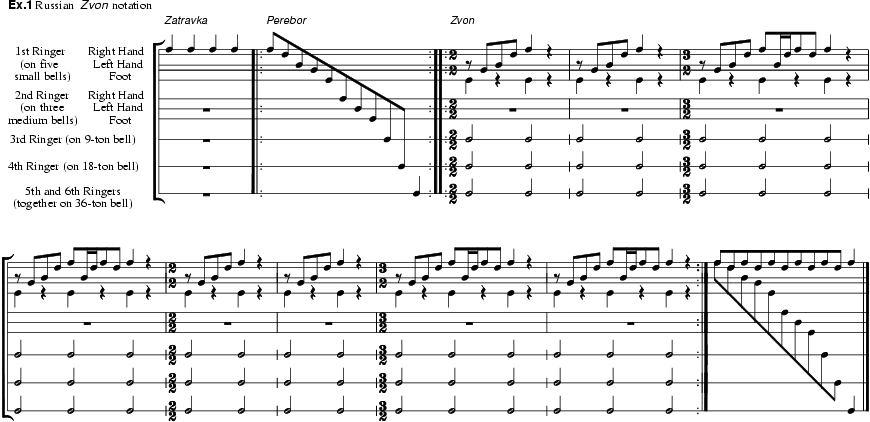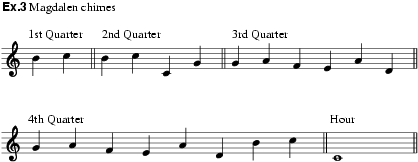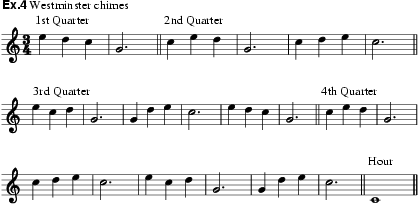
A generic term for a set of idiophones consisting of hollow, open tubes which, when struck at one end, emit a sound of definite pitch (the Gong-chime and Drum-chime do not belong to this category; for the modern Western type, as used in symphony orchestras, see Tubular bells). The term more specifically denotes a set of tuned, stationary bells, less extensive than a Carillon, as well as the music on such bells.
The word ‘chimes’ is derived from the Latin cymbala (plural of cymbalum, ‘bell’). ‘Chimes’ may now refer to a set of bells large or small, hung indoors or out, provided they are of limited range, are fastened stationary and are struck to sound (see also Wind chime). Such an instrument, older than the carillon, may have as few as two bells, as on many clock chimes, or a sequence – predominantly diatonic – of up to two octaves. It is used primarily for performing unaccompanied melodies (except in the Russian tradition, where the rhythmic and harmonic properties are more important than the melodic dimension).
Around the 5th century bce in China chimes of nine to 16 bells, called bianzhong (see Zhong), were taken into the instrumental ensemble used in Confucian rites. At first the bells were hung on a low cross-bar, and the player sat on the floor and tapped them with a light hammer; later they were hung higher on several cross-bars and the player stood in front of them. The instrument was adopted in Korea and Japan. At the end of the 18th century it went out of use except in Korea, where it is still played in religious and classical court music (see fig.1).
In western Europe the first use of the word chome referred to a clockwork mechanism on which chant melodies could be sounded (see §2 below; for a discussion of medieval cymbala, see Cymbala, §2).
From the 17th century some Russian chimes, trezvon, have exceeded in number and size of bells any western European installations of swinging bells (possible because chiming does not put a lateral thrust on the tower as does the swinging of heavy bells). The largest trezvon comprised over 20 bells, the heaviest weighing 30 or 40 tons. Ringing the whole range of bells was reserved for the most important occasions, with fewer and smaller bells used on less important ones. The largest trezvon would require half a dozen ringers in the bellchamber, some manipulating ropes attached to the clappers of small bells, others pulling a single rope to the clapper of a large bell, and two men standing facing each other under the largest bell, pushing its clapper back and forth. Before the days of electrical amplification no musical instrument produced so loud a sound. The ordinary church would of course have fewer and lighter bells, on most occasions sounding only four or five rung by one man (two with each hand and one with a foot; see fig.2). Before the end of the 19th century Russian bells were not tuned to a scale. The resulting dissonances particularly of tritones, were highly prized and individual bells were given such folk names as ‘The Swan’, ‘The Goat’ or ‘Red Bell’. The true delight of Russian chiming was the interplay of high and low sounds of indefinite pitch, some mellow, some cacophonous, rendered in carefully executed rhythmic patterns. To obtain this effect in Boris GodunovMusorgsky, in his original score, called for a trezvon on stage with the heaviest bell weighing 15 tons. This use of real bells is in addition to the simulation of bells in the orchestra score, in the Coronation scene (Prologue, scene ii). In the latter, the music accurately depicts the rhythmically controlled striking/chiming of the trezvon. Other composers inspired by Russian chiming include Rachmaninoff and Stravinsky. Ex.1 shows the scoring of a rhythmic pattern for a heavy 11-bell trezvon.

The other Eastern churches have not developed any comparable bell music, for they seldom chime more than one bell. But in the upper Rhône valley in Switzerland, chiming on five or six bells is rendered with considerable expression by a solo chimer in the bellchamber. In some European towers with swinging bells the ringers occasionally attach their bell ropes to move the clappers instead of the bells, enabling them to play tunes that could not be played by swinging the bells. In the 19th century some English peals were equipped with hammers to strike the bells when they hung still; these were operated by ropes leading to a lower part of the tower, so that when ringers were unavailable the bells could be sounded from below by one person such as the sexton. This was called the ‘Ellacombe’ system.
In the USA and Canada there was a unique development of chiming, partly because there was no established church to set one method of ringing, and partly because many towers, although outwardly copies of sturdy European structures, were not strong enough to support more than one or two bells in swinging motion. Consequently, chimes of eight to 14 fairly heavy bells were installed; their hammers were connected to a ‘chimestand’ on the floor below the bellchamber, where they were connected to levers like large pump-handles which the player pushed down. Hymn tunes and other airs that could be adapted to the range, with an occasional ‘alto’ harmony note added, were played on these chimes. Most of these tower instruments were made between 1870 and 1940 by the McShane foundry in Baltimore, Maryland, the two Meneely foundries in Troy, New York, and the Van Dusen foundry in Cincinnati, Ohio. The music played on them was simple, but it had a captive audience both in churchgoers and in students at colleges and universities, where hymn tunes would float out over the campus every morning from a central bell tower. At other times the chimes aroused school spirit by playing college songs. This chime music paved the way for the later proliferation of carillon music across the continent, and set early standards for judging it. As a prestigious adornment of American campuses, the chimes created an opening for the establishment of the carillon and the development of its music in American universities.
From the 2nd century bc automatic timepieces were used by Mediterranean peoples. Before bells were put to this purpose the sound for marking elapsed periods of time was made by dropping metal balls into a bronze pan similar to the metal frame of a Roman drum or tympanum. Later this device became a type of doorbell for Roman houses and was the progenitor of the French and Spanish timbre, a shallow hemispherical bell widely used on clocks, and at the end of the 19th century adopted for the telephone. By the 8th century ad bells of more conventional shape were also used on timepieces in China as well as Europe. In both regions they were first struck by puppets, known in English as ‘clock jacks’; these served both a mechanical function and the talismanic one of keeping unseen forces from sounding the bells. Older than dials on clocks, they were essential to an illiterate population unable to read figures on a dial.
From the single jack there evolved the use of two jacks striking two bells in succession. This gave the first chime tune, and one still in universal use for indicating the quarter-hours, called ‘ting-tang quarters’. The interval between the two notes was not fixed. (The Chinese combination was a bell and a drum to symbolize the Confucian balance of Yin and Yang.) Gradually more bells were added, at first no idea of scale relationship; the singularity of their sound had value rather as an audible identification of the tower and the town at night or in a fog.
In the ealry 14th century a weight-driven rotating cylinder with pegs to move the bell hammers was introduced (see Musical clock). This allowed more bells to be sounded, and more rapid playing. Jacks went out of use, the bells were increased in number and tuned to a scale, and chimes came to be heard as music. On some indoor clocks this music was made quite elaborate, and the most luxurious examples incorporated various instruments and also visual effects.
The chime bells of public tower clocks had a far-reaching sound, and before small clocks were in general use these instruments were important in regulating daily urban life. Some of these constantly repeated bell sequences – with a whole city as a captive audience – were given words and became folksongs, as did Frère Jacques, expanded from a three-bell chime, and Turn again, Whittington (see ex.2) out of one for six bells.

Strains of religious music were also used as hourly chimes on some buildings, both religious and secular, for example the first notes of Veni Creator on the city hall clock of Caen from 1597. The English habit of ‘quarter chimes’, not much followed on the Continent, is to increase the length of the chime as the hour proceeds, as in the Magdalen Chimes (Oxford, 1713; see ex.3), Carfax Chimes (Oxford, but first used at Freshwater in 1895), Guildford Chimes (1843), Beverley Minster Chimes (1902), the various forms of the Whittington Chimes, etc. The best known of all clock chimes, the Westminster Quarters (see ex.4), was derived from a quatrain in Handel’s Messiah. In 1794 William Crotch wrote four variations on the fifth and sixth bars of ’I know that my Redeemer liveth’ and proposed them as chimes for the new Cambridge University clock in Great St Mary’s Church. They were accepted, and in 1845 were copied on the Royal Exchange clock, London. In 1859–60 they were reproduced on the much larger bells of the tower clock of the new Houses of Parliament, Westminster, from which they took their present name. They have subsequently been copied on clocks large and small around the world.


Further mechanical developments involved changing the chiming cylinder, originally wooden with fixed pegs, into a perforated metal cylinder with replaceable pegs, so that new music could be set on it. In the Low Countries this was built large enough to play full Carillon music on several octaves of bells for five or six minutes without repetition. The cylinder is now usually replaced by a variety of electrical devices, most of which operate magnets to control the striking of the hammers.
Grove5 (W.W. Starmer)
C. Schott: Technica curiosa (Nuremberg, 1664)
W.W. Starmer: ‘Chimes’, PMA, xxxiv (1907–8), 1–24 [on English chimes]
W.W. Starmer: ‘Chimes and Chime Tunes’, PMA, xxxvi (1909–10), 93–107 [on continental chimes]
J. Smits van Waesberghe: Cymbula: Bells in the Middle Ages, MSD, i (1951)
R.H. Dove: Church Bells of Britain (Aldershot, 1962)
A. Lehr: Van Paardebel tot Speelklok (Zlatbommel, 1971, 2/1981)
P. Price: Bells and Man (Oxford, 1983)
PERCIVAL PRICE/HÉLÈNE LA RUE and BODMAN RAE (1), PERCIVAL PRICE (2)